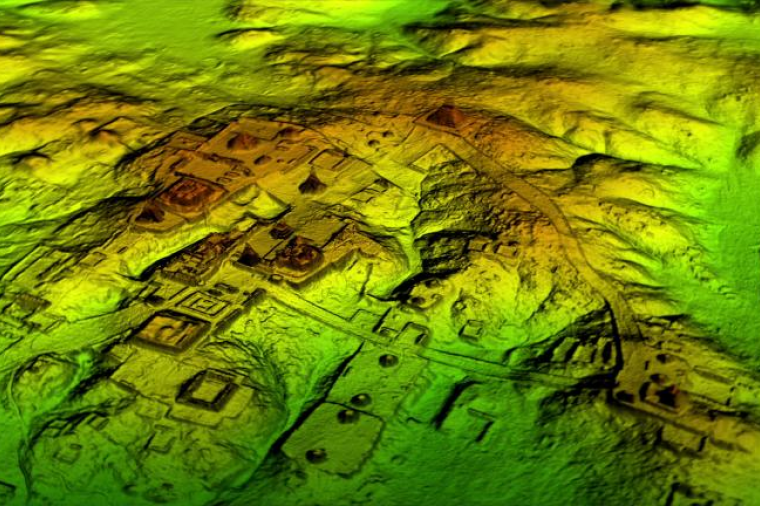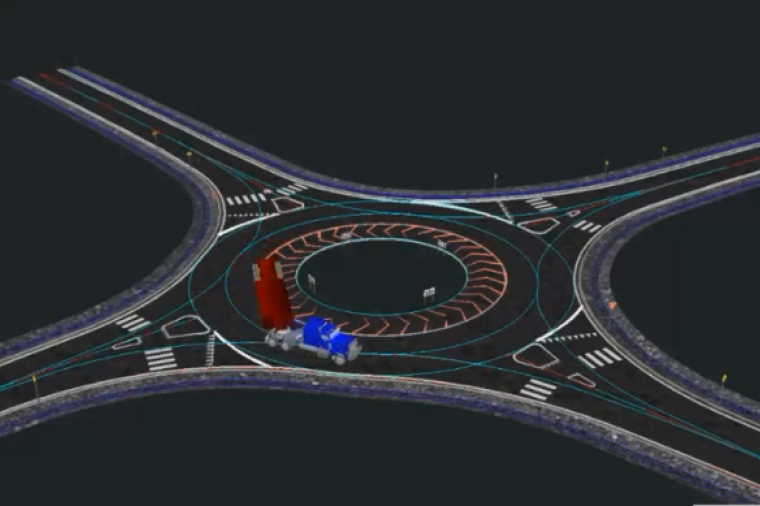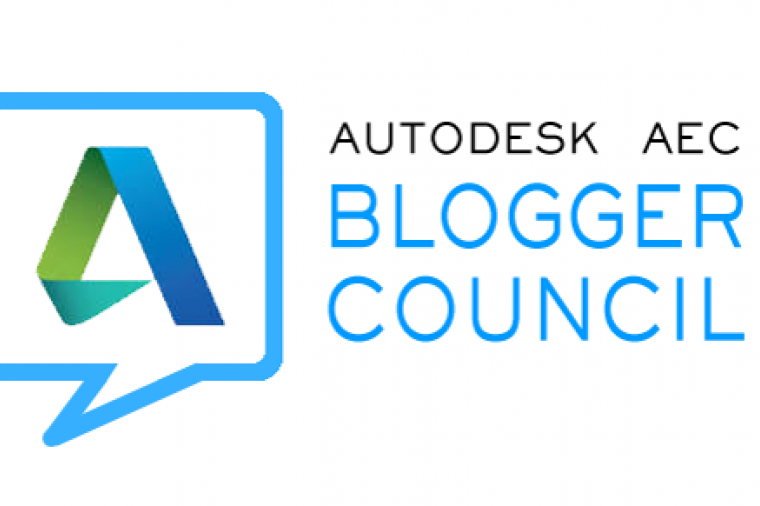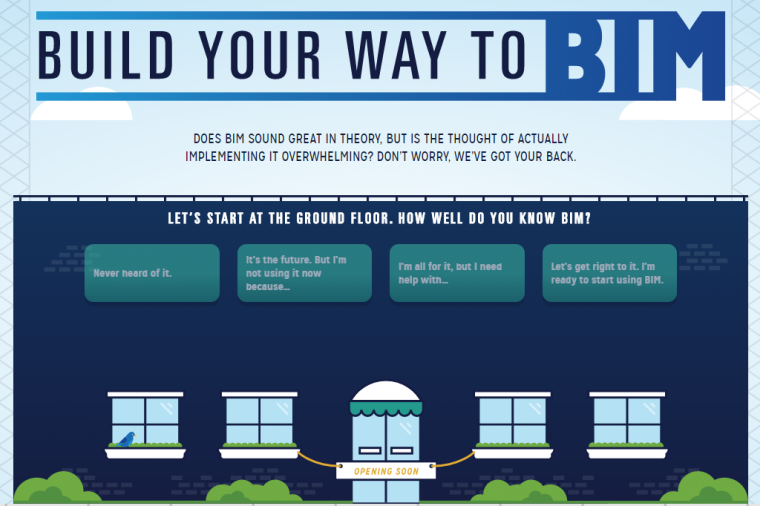Digital Design
Building information modeling (BIM) is poised for greater adoption by federal, state, and local government agencies. In Wisconsin, for example, publicly-funded projects over $5 million are required to incorporate BIM and 3D software from initial planning concepts to bidding documents and project closeout. Many DoTs, including MassDOT, FDOT, and CALTRANS are also embracing BIM for infrastructure projects.
Digital Design
It’s hard to imagine a world without digital. But as you look around you, much of the physical world was designed and constructed using traditional 2D blueprints and is yet to be captured in a digital format. This creates a challenge for AEC professionals to incorporate these as-built designs into re-build or renovation projects.
Traditional imaging techniques like photogrammetry aided in this process by allowing engineers to piece together photographs of as-built conditions and weave in GPS coordinates to create interactive 3D models, see below:
Digital Design
Rich3D, GovDesignHub explain how they delivered complex helicopter and military vehicle 3D virtual training via a ubiquitous tool – an Adobe Acrobat document.
The U.S. Marine Corps and the U.S. Navy need highly interactive 3D tools to deliver complex animated virtual training and simulation environments for helicopter pilots, crane operators and other professionals. And government contractor Rich3D uses a variety of 3D design tools to develop and deploy the interactive training environments they need.
Digital Design
For government organizations and municipalities, ensuring everyone is on the same page in terms of core competencies is an essential prerequisite to the success of any digital design or engineering project. With the pressure to do more with less, knowledge gaps can stymie team productivity, lower your return on investment in software tools, and make everyone’s lives a lot more difficult.
Digital Design, Uncategorized
New York City Department of Design and Construction (NYC DDC) handles some of the most exciting and dynamic architectural and infrastructure challenges in the world.
Digital Design
Bolstering the U.S. manufacturing sector is a message that has played into election campaign promises and White House administration policy for decades. The reality is a different story.
CAD General, Digital Design, IT Perspective, Technology, Uncategorized
Aside from developing one of the sought after building information modeling (BIM) software in the industry today, you’ve got to hand it to the Revit product managers over at Autodesk—they listen.
Digital Design, Technology, Tips and How-Tos, Uncategorized
If you’re fairly new to Autodesk Revit and looking for ways to quickly get up to speed, Autodesk put together a great webinar that offers tips and tricks to get the most out of your user experience. Topics included:
• How does it differ from AutoCAD?
• What do I need to know to get started?
• What are some best practices for working in Revit?
• What are families and how do I use them?
• Where to learn more and how to get support when problems happen
Buildings, CAD General, Infrastructure, Technology
If you currently use Autodesk’s flagship civil engineering design software, AutoCAD Civil 3D, you may have heard about its close cousin, InfraWorks. InfraWorks is an infrastructure design software that supports BIM processes and helps designers and engineers work in infrastructure projects in a real-world context using cloud capabilities.
Buildings, CAD General, Digital Design, Infrastructure, Technology
The use of building information modeling (BIM) data by building owners and facilities managers is on the rise, a survey by DLT partner, IMAGINiT Technologies reveals. Compared to 2016, the percentage of owners integrating BIM data into facilities management (FM) systems has increased by almost 9%. Yet challenges remain. Many organizations aren’t prepared or equipped to make the process and technology changes required for BIM adoption.
CAD General, Infrastructure, Technology
Archeological surveys in untouched areas are tricky at the best of times. Vegetation and trees must be disturbed, heavy equipment is brought in, and the results can still prove inconclusive or fruitless.
But thanks to laser technology, that’s all changing. LiDAR (aka Light Detection and Ranging technology) is helping archeologists champion scientific research without disturbing the natural habitat.
Buildings, CAD General, Infrastructure
A few years ago, Autodesk launched its cloud strategy. A commitment to bring cloud-based solutions to all of its vertical industry offerings. A core cloud offering, BIM 360 is a cloud-based design collaboration tool for the building and construction. It represents a shift from the “modeling” to the “information” phase of BIM – Autodesk calls it “Connected BIM”. BIM 360 connects design and construction across the project lifecycle using intuitive, linked workflows.
CAD General, Infrastructure, Technology
When it comes to transportation and site design projects, they all have one thing in common – when finished they need to accommodate a variety of different vehicles, from cars to fire trucks, airplanes to school buses. As a result, it’s important that these vehicle maneuvers be analyzed and incorporated throughout the entire design process. Autodesk Vehicle Tracking (AVT) can help.
CAD General
Perhaps you’re considering BIM for your next agency or department’s next building, facilities management, or civil infrastructure project. But what’s the best way to make sure you get full value from your investment in BIM?
Digital Design
It doesn’t matter whether you work in the federal, state or local government, rolling out any new software to your workforce can be a challenge. This is especially true of CAD software. Oftentimes, a department may upgrade from AutoCAD to a discipline-specific tool like AutoCAD Civil 3D or Revit, or depart radically from an old way of doing things with new software.
Team leads or CAD managers face several challenges. Standards must be reviewed and modified, staff must be trained, trial projects must be identified, and user/management expectations met.
Digital Design
Did you know that construction is anticipated to be the largest use case for commercial drones?
Drones can collect a site’s progress with a degree of accuracy previously unseen in the industry and reduce the amount of building site materials that end up in landfills. Furthermore, that sensor data can be turned into 3D models, maps, and volumetric measurements (which can help monitor and track costly gravel and sand inventory).
Digital Design
Look out for the pot hole! Did you know that one out of every five miles of highway pavement is in poor condition and in need of rehabilitation? If you’re a civil engineer, you’re probably not surprised. The bulk of highway system funding goes towards highway repair, and with good reason.
Digital Design
Hurricane season is far from over, but with four major hurricanes – Category 3 or greater – already causing untold damage in Texas, Florida, and Puerto Rico, 2017 has already proved to be a brutal one.
Digital Design
AutoCAD Civil 3D is about to get another round of enhancements. If you’re using Civil 3D 2018, be the first to learn what’s new in this upcoming webinar on September 20th, 2017 at 12.00 PM ET.
Join the Civil 3D product team as they share a preview of what’s coming in the AutoCAD Civil 3D 2018.1 Update.
You’ll learn about some of the major efficiency improvements to common workflows including:
Digital Design
You don’t have to go far to hear concerns about infrastructure decay in the U.S. In 2017, the American Society of Civil Engineers (ASCE) ranked the country’s infrastructure at a D+ grading.
Digital Design
I can’t think of another Autodesk product that sees so many rolling updates as Autodesk InfraWorks 360. In addition to the annual release (get a round-up of what’s new in the 2018 software here), new features and capabilities are being added throughout the year. Subscription customers can download these updates via the Subscription Center.
Regular updates and improvements are great, but how do you stay on top of what’s new and put it to use in your design projects?
Digital Design
As BIM gains ground in transportation infrastructure, with 52% of contractors now deploying it in their projects, BIM is fast becoming a “must-have” – reducing risk and waste, and enabling a more responsible way to design, build, operate and maintain roads, bridges, and more.
But how does that translate to the nuts and bolts of on-the-ground real-life projects? How and where does BIM fit into the lifecycle of a project? And, how can you use BIM to connect each phase for more effective results.
Digital Design
The U.S. Department of Veterans Affairs (VA) has long been a proponent of Building Information Modeling (BIM). In 2010, VA issued its Building Information Lifecycle Vision or “BIM Guide” stating its commitment to move the organization and its service providers to BIM “as effectively and efficiently as possible”.
Digital Design
The use of BIM for infrastructure in the U.S. is well on the way to becoming established for transportation projects. These are the findings of a new SmartMarket Report – The Business Value of BIM for Infrastructure – from Dodge Data & Analytics and DLT partner, Autodesk.
Digital Design
Autodesk InfraWorks 360 and AutoCAD Civil 3D 2018 are here!
For infrastructure and transportation civil engineers and designers, the new releases incorporate feedback from users and stress better economics, practicality, resiliency and attractiveness in the conception, design and construction of road, highway, bridge, land, and other infrastructure projects.
Digital Design
The revitalization of U.S. infrastructure is once again a hot topic as the new White House administration pledges to invest in the nation’s roads, bridges and airports. Politics aside, it’s a timely imperative. Once again, the American Society of Civil Engineers (ASCE) has ranked U.S. infrastructure at a D+ grading.
Digital Design
City and county infrastructure designers and civil engineers won’t want to miss this unique webinar series taking place every Tuesday through May 2017.
Join a host of familiar Autodesk faces as they walkthrough the phases of a challenging roadway project. From gathering data about the existing situation, producing a project concept, moving that concept to the detailed design phase, conducting additional analysis, and finally creating compelling visualizations to share with project stakeholders, including low cost virtual reality.
Digital Design
If you’re like most designers, engineers, or CAD managers, you probably rely on Windows Explorer and mapped network drives to manage and store project files. For instance, you may have one drive for design data, another for admin, another for permits, and so on. While it’s been the way you’ve done things for years, this habit of breaking your project up into pieces is a problematic approach that can result in misplaced data, poor version control, or deleted data due to incorrect file access control.
Digital Design
It’s no surprise that the practice of designing, building, and operating public sector buildings and infrastructure must change. As our built environments become increasingly complex, it’s vital that project team productivity and asset performance levels are addressed. According to KPMG, just a quarter of construction projects in the last three years came within 10% of their original deadlines.
Digital Design
As you may know Autodesk Industry Collections became available to government agencies as of February 1. This date also coincided with the retirement of perpetual licenses for most of its products, including AutoCAD, Civil 3D, Inventor, Revit, and more. But what’s so great about these new collections and how do they differ from the old Autodesk Suites?
First let’s explain what a collection is.
Digital Design
The role of the Army National Guard has expanded significantly since 9/11 and represents 40% of the U.S. Army’s total combat capability supporting Joint Commanders across the range of military operations around the globe.
Digital Design
Over the last decade, BIM has radically transformed design and construction projects and is seeing increased adoption in the U.S. government sector.
Digital Design
As a government user of Autodesk software, you may be aware that Autodesk is changing its licensing policy. Effective, January 31st 2017, the previous government extension will end and users will no longer be able to purchase perpetual licenses. You can read more about the specifics of the changes here.
Digital Design
Keeping track of all the documents involved in any construction or infrastructure project can be quite a headache. RFIs, design changes, estimates, mark-ups, approvals, and more, not forgetting the many-to-many relationships involved in the process. Sub-contractors are on and off the construction site, changes, issues, and requests are sent back and forth, new document sets are created and versions are updated.
Digital Design
Last fall saw some major updates to Autodesk’s flagship civil engineering software - InfraWorks 360 and AutoCAD Civil 3D.
To give users an overview of what’s new, the Autodesk product team have come together for “The Dan and Dave Show” once more. What features will be added or updated? Why were these changes chosen over others? The on-demand video below includes answers to these questions and more from the guys who call the shots when it comes to the development of InfraWorks 360 and Civil 3D.
Digital Design
We’ve written quite a lot about BIM lately, most notably its spotty adoption in government for civil engineering projects, airport infrastructure, and construction and facilities management.
Digital Design
If you’re a government user of Autodesk software, hold on to your hats. Autodesk is about to make some significant changes to the way its software can be procured.
What’s Changing?
Effective January 31, 2017, Autodesk will no longer sell perpetual licenses for most of its products, including AutoCAD, Civil 3D, Inventor, Revit, and more. You can view the full list of products affected here.
Digital Design
As Autodesk software gets more sophisticated and purchasing models change, users are getting access to new features as they become available and experiencing more seamless interoperability between products.
Digital Design
Flooding is one of the deadliest natural disasters. Few places can escape the wrath of excessive rain, ruptured dams or levees, rapid ice melt, or storm surges. Even states that we’d consider “dry” are vulnerable to the effects of flooding.
Digital Design
Earlier this year we blogged about the disconnect between building owners and AEC firms who work in BIM. Most AEC firms work in BIM, but most owners don’t use BIM.
Digital Design
Improvements in surveying data collection processes and hardware have made it easier for surveyors to capture multiple attributes in the field for downstream surveying, engineering, and integrated GIS usage.
For end users, this translates to an enriched environment and new opportunities for transportation and civil engineers. However, in the past, these users have been restricted to using differing versions of the data, without a version of the full width and breadth of information captured – until now.
Digital Design
Whether you work in civil engineering, facilities management, or on infrastructure and construction projects, you understand the drivers and benefits of BIM. Yet despite this, there’s a very real chance that you’re not currently embracing BIM.
Why is that?
Digital Design
A few weeks ago Autodesk announced updates to its popular InfraWorks 360 preliminary engineering design software. Among these was the addition of several new powerful component road and transition workflows features that allow you to model more detailed and accurate roads.
The new functionality includes:
• User definable transitions of various elements, enabling you to create realistic bus bays, lane transitions, and median transitions
Digital Design
BIM, a process for creating and using a 3D intelligent model for planning, designing, building, and managing infrastructure, is used across multiple industries to get accessible and actionable insight throughout project lifecycles. BIM improves coordination, creates and delivers intelligent models, and reduces rework and material waste.
Since utilities drive some of the largest construction budgets, applying the principles of BIM as you update old and build new infrastructure can improve cost control and reduce construction waste below the typical 30% level. How?
Digital Design
Just as our access to life-supporting resources is declining, our consumption of life supporting resources is on the rise. It’s a troubling dichotomy that is leading to increased policy making and regulation that puts pressure on federal, state, and local agencies to take action.
Digital Design
The much beloved Autodesk Land Desktop civil engineering solution was discontinued almost 10 years ago and replaced by Civil 3D, but that’s not to say it went away entirely.
However, Land Desktop is no longer supported by Autodesk (i.e. no technical assistance if things go wrong, hot fixes, or service packs). Additionally, civil engineering software, in the form of Civil 3D, has evolved drastically since 2008, adding more features, functionality and product integrations.
Digital Design
For government building owners and managers, BIM delivers demonstrable value from design, through construction, and into operations. In fact, BIM is just as much about digitizing facilities management (FM) as it is about virtual construction says Kath Fontana, FRICS, in her article, 10 things facilities managers should know about BIM.
Digital Design, Uncategorized
The dog days of summer are officially here. So what better time to brush up on your digital design skills. Here are some options for getting ahead of the curve this summer.
Digital Design, Uncategorized
Building Information Modeling (BIM) isn’t a concept that springs to mind for enabling the delivery of reliable, high-quality electric service. Yet, BIM is increasingly helping U.S. and global utilities deliver more reliable, higher quality service.
Digital Design, Uncategorized
Federal and state / local government agencies are increasingly moving towards requiring BIM on most of its building projects (GSA, ASCE, Veteran’s Affairs, Air Force and Coast Guard on the federal side and Wisconsin and Ohio at the state level to name a few).













































